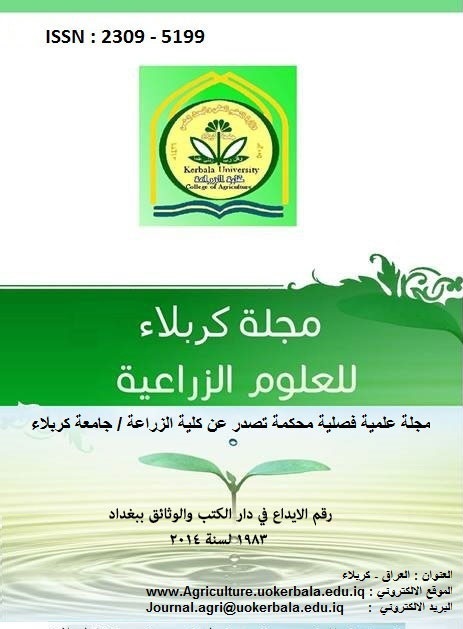Predict of field emergence for several plant species through some la-boratory germination tests
S. H. Cheyed1 N. J. Mohammed2 J, H. Hamza1
DOI:
https://doi.org/10.59658/jkas.v4i1.85Keywords:
البزوغ الحقلي و فحوص حيوية وقوة البذرة و الذرة الصفراء و الذرة البيضاء و زهرة الشمس و العصفرAbstract
The wide range of genetic and environmental variations in which plant species grow, makes predicting its field emergence extremely complex matter. Therefore this study aimed to predict field emergence through laboratory germination tests for two cultivars of each of maize (Baghdad-3 and Fejir), sorghum (Jiza-113, Inqath), sunflower (Akmar and shomoos) and safflower (Urduni and Al-mays). A laboratory and field experiment was carried out with one factor which is laboratory germination tests (standard germination test, cold test and accelerate age test) as well as the field emergence in the fall season of 2015 of species above in the laboratories of department of seed certification and testing, the Public Authority for Agricultural Research and fields of Field Crops Department, College of Agriculture, University of Baghdad. Analysis of variance was carried out according to the design of randomized complete block with eight replications for each variety separately, and the treatments average were compared with the least significant difference test (p value = 0.05). In general, results of variance analysis showed significant differences for influence of laboratory germination methods and field emergence in the percentage of normal seedling, but there were no significant differences also between the field emergence and among some of those methods, which refers to the possibility of predicting field emergence through it, since there was no significant difference between the percentage of normal seedling of field emergence and its percentage in each one of accelerate age test for maize seed both cultivars Baghdad-3 and Fajir, its percentage in standard laboratory germination test and accelerate age test for sunflower seed both Akmar and shomoos, and its percentage in accelerate age test for safflower seed Al-mays variety. There was also a significant difference between the percentage of normal seedling of field emergence and its percentage in each of other tests of sorghum seeds both cultivars (Giza-113 and Inqath) and safflower seed Urduni variety, which indicates unpredictability field emergence for it through those tests. We conclude that the seed tests vary in their ability to predict the field emergence according to differences of species and its varieties. And accelerate age test often resemble the field emergence and can promise as one of the indicators that can be used to predict the field emergence of those varieties that are planted in fall seasons.
Downloads
Published
How to Cite
Issue
Section
License
Copyright (c) 2018 Copyright (c) 2024 is the Author's article. Published by the Journal of Kerbala for Agricultural Sciences under a CC BY 4.0 license

This work is licensed under a Creative Commons Attribution 4.0 International License.
Licensing Terms
All articles are published under a Creative Commons License and will be directed to the Creative Commons Attribution 4.0 International License (CC BY 4.0) That permits use, distribution, and reproduction in any medium, provided the original work is properly cited. This license also allows the work to be used for commercial purposes.
Use by both non-commercial and commercial users
This content is licensed under a Creative Commons Attribution 4.0 International (CC BY 4.0) license, permitting use by both non-commercial and commercial users. Individual users may access, download, copy, display, and redistribute the articles to colleagues, as well as adapt, translate, and text- and data-mine the content, subject to the following conditions:
- The author's moral rights, including the right of attribution and the right to protect their work from derogatory treatment, are respected.
- Where content in the article is identified as belonging to a third party, users must ensure that any reuse complies with the copyright policies of the owner of that content.
- If the article content is reused for research or educational purposes, users should maintain a link to the appropriate bibliographic citation, including the DOI and a link to the published version on the journal's website.

